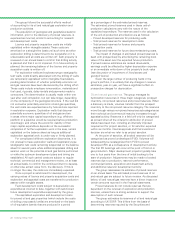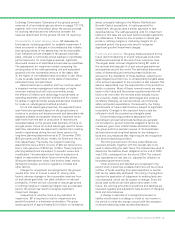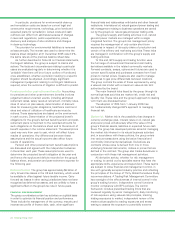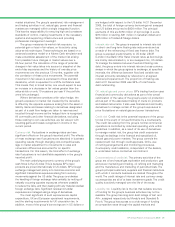BP 2005 Annual Report Download - page 34
Download and view the complete annual report
Please find page 34 of the 2005 BP annual report below. You can navigate through the pages in the report by either clicking on the pages listed below, or by using the keyword search tool below to find specific information within the annual report.32 Making energy more
group, the expenditure is capitalized. Inspection costs associated with
major maintenance programmes are capitalized and amortized over
the period to the next inspection. Overhaul costs for major
maintenance programmes are expensed as incurred. All other
maintenance costs are expensed as incurred.
Oil and natural gas properties are depreciated using a unit-of-
production method. The cost of producing wells is amortized over
proved developed reserves. Licence acquisition, decommissioning
and field development costs are amortized over total proved reserves.
The unit-of-production rate for the amortization of field development
costs takes into account expenditures incurred to date, together with
sanctioned future development expenditure.
Other property, plant and equipment is depreciated on a straight-
line basis over its expected useful life.
The useful lives of the group’s other property, plant and equipment
are as follows:
Land improvements 15 to 25 years
Buildings 20 to 40 years
Refineries 20 to 30 years
Petrochemicals plants 20 years
Pipelines Unit-of-throughput
10 to 50 years
Service stations 15 years
Office equipment 3 to 7 years
Fixtures and fittings 5 to 15 years
The expected useful lives of property, plant and equipment are
reviewed on an annual basis and, if necessary, changes in useful lives
are accounted for prospectively.
The carrying value of property, plant and equipment is reviewed for
impairment whenever events or changes in circumstances indicate
the carrying value may not be recoverable.
An item of property, plant and equipment is derecognized upon
disposal or when no future economic benefits are expected to arise
from the continued use of the asset. Any gain or loss arising on
derecognition of the asset (calculated as the difference between the
net disposal proceeds and the carrying amount of the item) is included
in the income statement in the period the item is derecognized.
IMPAIRMENT OF INTANGIBLE ASSETS AND PROPERTY, PLANT
AND EQUIPMENT
The group assesses assets or groups of assets for impairment
whenever events or changes in circumstances indicate that the
carrying value of an asset may not be recoverable. Individual assets
are grouped for impairment assessment purposes at the lowest level
at which there are identifiable cash flows that are largely independent
of the cash flows of other groups of assets. If any such indication of
impairment exists or when annual impairment testing for an asset
group is required, the group makes an estimate of its recoverable
amount. An asset group’s recoverable amount is the higher of its fair
value less costs to sell and its value in use. Where the carrying
amount of an asset group exceeds its recoverable amount, the asset
group is considered impaired and is written down to its recoverable
amount. In assessing value in use, the estimated future cash flows
are adjusted for the risks specific to the asset group and are
discounted to their present value using a pre-tax discount rate that
reflects current market assessments of the time value of money.
An assessment is made at each reporting date as to whether there
is any indication that previously recognized impairment losses may no
longer exist or may have decreased. If such indication exists, the
recoverable amount is estimated. A previously recognized impairment
loss is reversed only if there has been a change in the estimates used
to determine the asset’s recoverable amount since the last
impairment loss was recognized. If that is the case, the carrying
OIL AND NATURAL GAS EXPLORATION AND DEVELOPMENT EXPENDITURE
Oil and natural gas exploration and development expenditure is
accounted for using the successful efforts method of accounting.
Licence and property acquisition costs Exploration and property
leasehold acquisition costs are capitalized within intangible fixed
assets and amortized on a straight-line basis over the estimated
period of exploration. Each property is reviewed on an annual basis
to confirm that drilling activity is planned and it is not impaired. If no
future activity is planned, the remaining balance of the licence and
property acquisition costs is written off. Upon determination of
economically recoverable reserves (‘proved reserves’ or ‘commercial
reserves’), amortization ceases and the remaining costs are
aggregated with exploration expenditure and held on a field-by-field
basis as proved properties awaiting approval within other intangible
assets. When development is approved internally, the relevant
expenditure is transferred to property, plant and equipment.
Exploration expenditure Geological and geophysical exploration costs
are charged against income as incurred. Costs directly associated
with an exploration well are capitalized as an intangible asset until the
drilling of the well is complete and the results have been evaluated.
These costs include employee remuneration, materials and fuel
used, rig costs, delay rentals and payments made to contractors. If
hydrocarbons are not found, the exploration expenditure is written
off as a dry hole. If hydrocarbons are found and, subject to further
appraisal activity, which may include the drilling of further wells
(exploration or exploratory-type stratigraphic test wells), are likely to be
capable of commercial development, the costs continue to be carried
as an asset. All such carried costs are subject to technical, commercial
and management review at least once a year to confirm the continued
intent to develop or otherwise extract value from the discovery. When
this is no longer the case, the costs are written off. When proved
reserves of oil and natural gas are determined and development is
sanctioned, the relevant expenditure is transferred to property,
plant and equipment.
Development expenditure Expenditure on the construction, installation
or completion of infrastructure facilities such as platforms, pipelines
and the drilling of development wells, including unsuccessful
development or delineation wells, is capitalized within property,
plant and equipment.
PROPERTY, PLANT AND EQUIPMENT
Property, plant and equipment is stated at cost, less accumulated
depreciation and accumulated impairment losses.
The initial cost of an asset comprises its purchase price or
construction cost, any costs directly attributable to bringing the asset
into operation, the initial estimate of any decommissioning obligation,
if any, and, for qualifying assets, borrowing costs. The purchase price
or construction cost is the aggregate amount paid and the fair value
of any other consideration given to acquire the asset. The capitalized
value of a finance lease is also included within property, plant
and equipment.
Exchanges of assets are measured at the fair value of the asset
given up unless the exchange transaction lacks commercial substance
or the fair value of neither the asset received nor the asset given up
is reliably measurable.
Expenditure on major maintenance refits or repairs comprises the
cost of replacement assets or parts of assets, inspection costs and
overhaul costs. Where an asset or part of an asset that was separately
depreciated and is now written off is replaced and it is probable that
future economic benefits associated with the item will flow to the
























